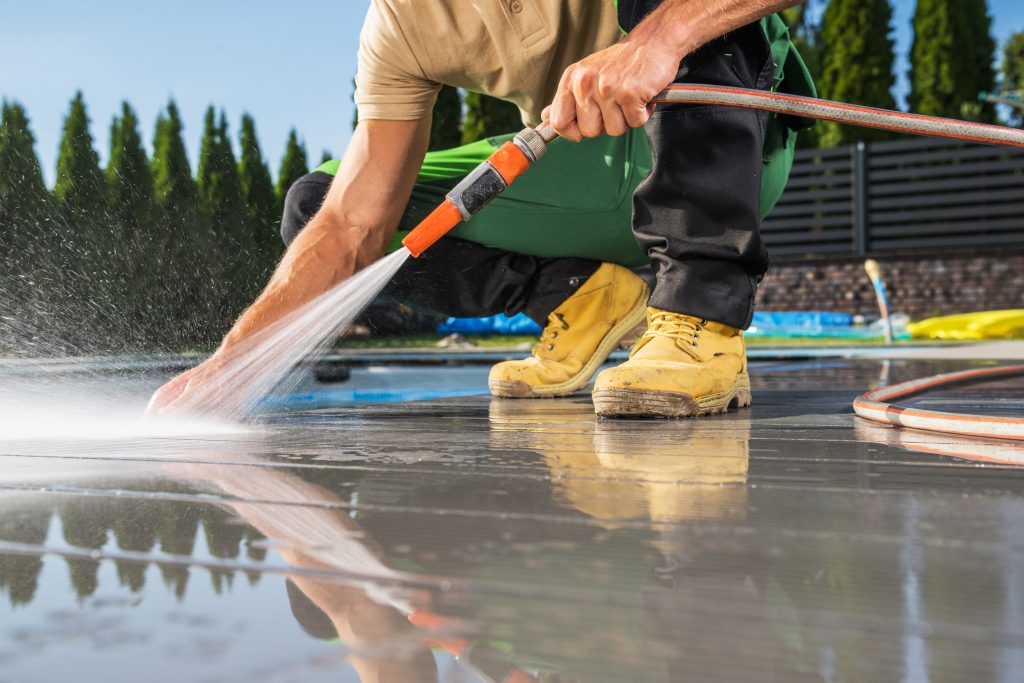
Slips, trips, and falls are among the leading causes of injury in public spaces, from sidewalks to parks to commercial entryways. But what many property managers and facility owners overlook is just how much dirty, slippery surfaces contribute to these incidents.
One of the most effective — and often underestimated — ways to reduce these hazards is through routine power washing. 🚿 In this article, we’ll explore how power washing plays a role in slip-and-fall prevention, the areas most at risk, and how to maintain safer, cleaner environments year-round.
🧠 Why Public Surfaces Become Slippery Over Time
Outdoor public areas are exposed to constant foot traffic, weather, pollution, and biological growth. Over time, these elements build up and create slick, dangerous surfaces:
- Algae and moss grow in shaded, moist areas
- Oil stains from vehicles or food spills create a greasy film
- Dirt, dust, and grime become compacted and slick when wet
- Chewing gum and debris create sticky or uneven patches
- Mildew forms on shaded concrete or stone, especially near water features
When these aren’t addressed regularly, the surface traction decreases — increasing the chances of a slip or fall. 😨
🧼 How Power Washing Improves Safety
Power washing, when done correctly, removes these hazards quickly and effectively by:
✅ Breaking down slippery organic growth (like algae, moss, and mildew)
✅ Lifting oily residues from concrete or tile
✅ Removing compacted dirt and grime
✅ Washing away loose debris, leaves, and litter
✅ Cleaning out the textured surface of non-slip materials
A clean surface has better traction, is easier to maintain, and greatly reduces liability risk. 🧯
Browse Amazon Here For Top Rated Power Washers And Accessories
🏙️ High-Risk Public Areas That Benefit from Power Washing
| Area | Common Hazards |
|---|---|
| Sidewalks and walkways | Algae, gum, food spills, and dirt buildup |
| Parking lots and garages | Oil leaks, mud, and automotive grime |
| Storefront entrances | Slush, foot traffic grime, spilled drinks |
| Restaurant patios | Grease, food waste, and slippery drink spills |
| Pool decks and splash pads | Mildew, sunscreen, algae |
| Public parks and trails | Mud, moss, fallen leaves, bird droppings |
| Transit stations and stairwells | Grime, spills, and high-traffic contamination |
When these areas are neglected, especially after rain or snow, the risk of falls skyrockets.
📉 Legal and Financial Risk of Ignoring It
Slips and falls can cost businesses and municipalities thousands — or even millions — in:
- 💰 Insurance claims and medical costs
- ⚖️ Legal fees and liability lawsuits
- 📉 Reputational damage (especially for hospitality venues)
- 🚫 Potential shutdowns from safety violations
Routine power washing is not only a safety solution — it’s a preventative risk management measure.
🧰 Power Washing vs. Other Cleaning Methods
| Method | Effectiveness | Best For |
|---|---|---|
| Sweeping | 🟡 Low | Loose dirt, leaves, and light debris |
| Scrubbing | 🟠 Moderate | Small patios or tile floors |
| Chemical mopping | 🟠 Moderate | Interior spills or sealed surfaces |
| Power washing | ✅ High | Outdoor buildup, embedded grime, biohazards |
Power washing is the only method that combines pressure, water flow, and optional detergent to clean deeply and efficiently.
🧪 Safe Products and Techniques for Anti-Slip Results
To maximize slip prevention, professional-grade power washing may include:
- Algaecides or anti-mildew treatments
- Degreasers for oil-heavy areas
- Hot water pressure washing for gum or grease
- Post-treatment with anti-slip sealants
Always use biodegradable cleaners when near waterways or parks. 🐟🌱
Browse Amazon Here For Biodegradable Pressure Washing Detergents
⚙️ How Often Should Public Areas Be Power Washed?
This depends on traffic, climate, and surface type. As a rule of thumb:
- High-traffic sidewalks: Monthly or bi-monthly
- Parking lots: Quarterly
- Pool areas: Before and after the swim season
- Restaurant patios: Every 1–2 weeks in peak season
- Transit stops and stairs: Bi-monthly or more frequently in winter
More frequent cleaning may be necessary after storms, festivals, or events.
🚧 Safety Tips During the Cleaning Process
Power washing itself can temporarily create slip hazards if not managed properly:
- Use wet floor signs and barricades during and after cleaning
- Clean in sections to allow dry zones
- Rinse thoroughly to avoid detergent residue
- Avoid blasting toward pedestrian traffic or doorways
Safety during the process is just as important as safety after it. 🛑
🧑🔧 Should You Hire a Pro?
Hiring a professional power washing service ensures:
- The right pressure and detergent are used for each surface
- Surfaces are treated to minimize future buildup
- Scheduling can be done outside of business hours
- Liability insurance and safety protocols are in place
For high-traffic or sensitive areas, professional service reduces risks and ensures compliance. ✅
🔚 Final Thoughts
Slippery surfaces in public areas are more than an inconvenience — they’re a serious safety and liability concern. Power washing is one of the fastest, most effective ways to prevent falls, maintain clean environments, and improve public perception.
Whether you’re a business owner, property manager, or city planner, integrating power washing into your regular maintenance plan can help keep your visitors safer and your reputation stronger. 💪🧼
Browse Amazon Here For Top Rated Power Washers And Accessories



